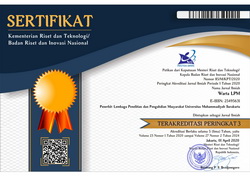Implementasi Emergency Fund dan Investasi Saham Syariah bagi Wirausaha Muda untuk Memperkuat Tata Kelola Keuangan dalam Menghadapi Krisis Akibat Covid-19
DOI:
https://doi.org/10.23917/warta.v25i2.646Keywords:
MSMEs, Student Entrepreneur, Emergency Fund, Sharia StocksAbstract
This community service program aims to improve MSME financial management, by increasing knowledge of financial planning and sharia stock investment. Participants are STIE EKUITAS entrepreneurial students consisting of 21 entrepreneurs. The service method adopts the concept of Plan, Do, Check, Action (PDCA), problem solving 101 (Ken Watanabe) and the capital market education model which is the result of the previous team’s research. The results of the PKM evaluation showed an increase in knowledge, but in advanced and practical material the knowledge of participants did not increase significantly. In the next service program, a more integrated and structured educational model is needed, involving various parties such as practitioners, academics, communities, the Indonesia Stock Exchange and securities companies, so that the program is more effective.
Downloads
References
Asnahwati, A., & Risman, R. (2018). Model Tata Kelola Keuangan Usaha Mikro Kecil Menengah (UMKM) Wanita. Jurnal Daya Saing, 4, 259–268. https://doi.org/10.35446/dayasaing.v4i2.250
Azhar Hussain, M., & Razak Abdul Hadi, A. (2018). Corporate Governance, Small Medium Enterprises (SMEs) and Firm’s Performance: Evidence from Construction Business, Construction Industry Development Board (CIDB) Malaysia. International Journal of Business and Management, 13(2), 14. https://doi.org/10.5539/ijbm.v13n2p14
Badan Pusat Statistik.(2016). Potensi Usaha Mikro Kecil Menengah Provinsi Jawa Barat. Sensus
Ekonomi
Cole, S., Sampson, T., & Zia, B. (2011). Prices or Knowledge? What drives the demand for financial services in developing countries. Harvard Business School Working Paper No. 09-117, LXVI(6), 1933–1967
Darmawan, H.; Hasibuan, S.; Hardi-Purba, H.(2018) Application of Kaizen Concept with 8 Steps PDCA to Reduce in Line Defect at Pasting Process: A Case Study in Automotive Battery. Int. J. Adv. Sci. Res. Eng. P: 97–107.
De Queiroz Albuquerque, A.C.R.(2015). Evaluation of the Application of the PDCA Cycle in Decision-Making in Industrial Processes; Federal University of Pará: Belém, Brazil,. (In Portuguese)
Fatwitawati, R. (2018). Pengelolaan Keuangan bagi Usaha Mikro Kecil Menengah (UMKM) di Kelurahan Airputih Kecamatan Tampan Kota Pekanbaru. Sembadha, 32.
Ghozie H. Prita.(2013) . Make it Happen. Jakarta: Gramedia
Herleni, S., & Tasman, A. (2019). Pengaruh Financial Knowledge dan Internal Locus of Control terhadap Personal Financial Management Behaviour Pelaku Umkm Kota Bukittinggi. Jurnal Kajian Manajemen Dan Wirausaha, 01(01), 270–275.
Htay, S. N. N., & Salman, S. A. (2013). Corporate Governance: A Case Study of SMEs in Malaysia. Middle East Journal of Scientific Research, 18(2), 243–252. https://doi.org/10.5829/idosi.mejsr.2013.18.2.12439
Irawaty, D. (2020). Pengelolaan Keuangan Keluarga Pada Era Pandemi Covid-19.
Jones, E.C.; Parast, M.M.; Adams, S.G. (2010). A framework for effective six Sigma implementation. Total Qual. Manag. 2010, 21, 415–424.
Keown, A., Martin, J., & Petty, W. (2014). Foundations of Finance - The logic and Practice of Financial Management 8e. In PEARSON. https://doi.org/10.2307/2326337
Kimiyaghalam, F., & Yap, S. (2017). Level of Financial Literacy in Malaysia. International Journal of Research, 4(7), 1065–1075.
Mariani, G., & Panaro, D. (2012). Corporate Governance and Performance in Turnaround: A synthetic index. Corporate Ownership and Control, 10(1 A), 62–74. https://doi.org/10.22495/cocv10i1art6.
Maruta, R.(2012). Maximizing Knowledge Work Productivity: A Time Constrained and Activity Visualized PDCA Cycle. Knowl. Process Manag, 19, 203–214.
Oehler, A., & Horn, M. (2019). Does Households’ Wealth Predict the Efficiency of their Asset Mix? Empirical Evidence. Review of Behavioral Economics, 6(3), 249–282. https://doi.org/10.1561/105.00000106.
Petra, U. K., & Petra, U. K. (2017). Produk investasi untuk penempatan dana darurat. 2017, 27–28.
Realyvásquez-Vargas, A., Arredondo-Soto, K. C., Carrillo-Gutiérrez, T., & Ravelo, G. (2018). Applying the Plan-Do-Check-Act (PDCA) Cycle To Reduce the Defects in the Manufacturing Industry. A Case Study. Applied Sciences (Switzerland). https://doi.org/10.3390/app8112181
Rinaldo, D. and Puspita, V.A. (2021) "Education and Socialization Investment Galleries to Improve Capital Market Inclusion", Barnett, W.A. and Sergi, B.S. (Ed.) Environmental, Social, and Governance Perspectives on Economic Development in Asia (International Symposia in Economic Theory and Econometrics, Vol. 29A), Emerald Publishing Limited, Bingley, pp. 169-184. https://doi.org/10.1108/S1571-03862021000029A025
Sailendra, S., & Pancasila, U. (2020). Tatakelola Keuangan dan Akses Permodalan UMKM terhadap Perbankan dalam Meningkatkan dan Pengembangan Nilai Ekonomi Usaha?: UMKM Pujasera Cempaka Putih Jakarta Pusat. (January 2019). https://doi.org/10.30874/capacitarea.2020.1
Sangpikul, A. (2017). Implementing Academic Service Learning and the PDCA Cycle in a Marketing Course: Contributions to three beneficiaries. J. Hosp. Leis. Sport Tour. Educ, 21, 83–87.
Sari, S., & K, R. S. (2020). Analisis Modal Kerja Dan Pengelolaan Keuangan Terhadap Pendapatan Usaha Mikro Kecil Dan Menengah (Umkm) (Studi Kasus Pada Umkm Bakso Pradah Di Kota Samarinda). 2(1), 560–567.
Shafron, E. (2019). Investor Tastes: Implications for Asset Pricing in the Public Debt Market. Journal of Corporate Finance, 55, 6–27. https://doi.org/10.1016/j.jcorpfin.2018.08.006
Silva, A.S, Medeiros, C.F, Vieira, R.K. (2017). Cleaner Production and PDCA Cycle: Practical application for reducing the Cans Loss Index in a beverage company. J. Clean. 4; 150, 324–338.
Sugiyono. (2017). Metode Penelitian Kuantitatif, Kualitatif, dan R&D. Bandung: Alfabeta, CV.
Tajra, F.S.; Lira, G.V.; Rodrigues, Â.B.; Tajra, R.S.(2012) PDCA As Associated Methodological Audit Health: Report of Sobral-Ceará. Mag. Tempus Actas Collect Heal, 8, 202–215.
Titman, Sheridan; Keown, Arthur J;,Martin, Jhon D.(2018). Financial management: principles and applications. ISBN: 978-1-292-22218-9 Edisi: 13th ed. Pearson Education. England: Harlow
Utama, Y. Y., & Arisanti, N. (2021). Coronavirus Disease 2019 and Cash Flow: Sebuah Studi Kualitatif. Jurnal Akuntansi Terapan Dan Bisnis, 1(1), 25–34. https://doi.org/10.25047/asersi.v1i1.2645
Watanabe, K (2009). Problem Solving 101. England : Penguin Books Ltd, Registered Offices:80 Strand, London WC2R 0RL.
Downloads
Submitted
Published
How to Cite
Issue
Section
License
Copyright (c) 2022 Warta LPM

This work is licensed under a Creative Commons Attribution 4.0 International License.















